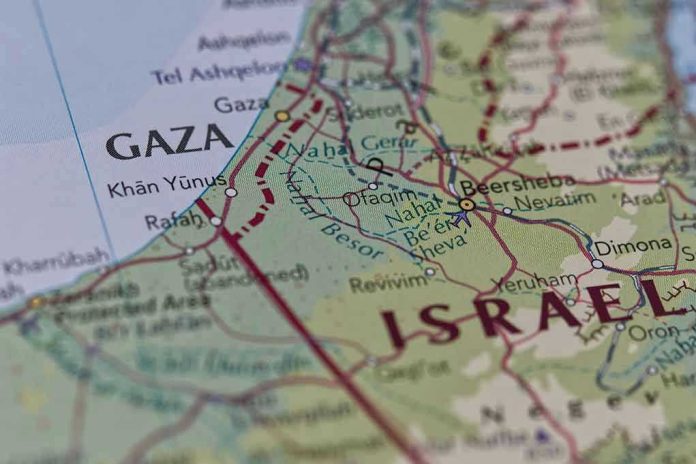
A single phrase—“It’s like a nuclear bomb has hit”—now defines the unimaginable aftermath facing Palestinians who have returned to Gaza, only to find their homes and entire neighborhoods erased from existence.
Story Highlights
- Nearly two million Palestinians displaced; Gaza’s infrastructure and neighborhoods reduced to rubble.
- Survivors describe devastation and trauma rivaling the aftermath of a nuclear explosion.
- International agencies warn of an unprecedented humanitarian crisis and potential war crimes.
- Efforts to deliver aid and restore normalcy repeatedly thwarted by siege, blockade, and continued hostilities.
Desolation Upon Return: The Human Cost Unveiled
Palestinian families, after months of forced displacement, have begun returning to what remains of their homes in Gaza. The experience is not just one of loss, but of absolute shock—entire city blocks reduced to dust, streets unrecognizable, and the skeletons of buildings standing as mute witnesses to the violence. What was once a vibrant community now resembles the aftermath of a cataclysmic event, with survivors likening it to a nuclear bomb’s devastation. The scale and intensity of the destruction have triggered a collective trauma that is both immediate and enduring.
Homes are no longer merely damaged—they have disappeared. Infrastructure supporting daily life, from water pipes to power grids, lies in ruins. Families wander through debris, searching for lost belongings and loved ones. The emotional toll is compounded by the utter uncertainty about the future, as survivors grapple with the knowledge that their communities may never recover, and that the loss encompasses not just material possessions but the very fabric of their lives.
Timeline of Catastrophe: From Attack to Ongoing Siege
The recent wave of devastation began on October 7, 2023, when Hamas attacked southern Israel, killing over 1,100 Israelis and taking hostages. Israel’s military response escalated rapidly, including widespread airstrikes, ground assaults, and orders for mass evacuation. By October 13, over a million Palestinians were forced to flee northern Gaza. The ground invasion started on October 27, and relentless military operations continued into 2024. Periodic ceasefires offered only brief respite before renewed assaults left more homes, schools, and hospitals destroyed. By October 2024, the UN reported that 1.9 million people—almost the entire population of Gaza—were displaced, with humanitarian agencies warning of starvation and medical collapse.
Each phase of the conflict compounded the misery. Blockades cut off essential supplies, and aid organizations faced severe restrictions, rendering relief efforts nearly impossible. The destruction of infrastructure meant that even those who managed to return home faced conditions unsuitable for human habitation, with no water, electricity, or medical care. The cumulative effect has been a humanitarian disaster of staggering proportions, with the suffering of civilians overshadowing any military objectives.
The Stakeholders and Their Agendas: Power, Survival, and Humanitarian Strain
The Israeli government and military have justified their operations as necessary for security and the elimination of Hamas, while Hamas continues to assert control over Gaza, framing resistance as a struggle against occupation. International organizations, including the UN and Red Cross, have focused on humanitarian relief and the protection of civilians. The power imbalance is stark: Israel’s military superiority and control over borders leave Hamas and Palestinian civilians with little recourse. Humanitarian agencies are hamstrung by restricted access, and the blockade has rendered even the most basic aid delivery a logistical nightmare.
Civilians are left to navigate a landscape defined by loss and uncertainty. Their primary concern is survival, followed by the desperate hope of returning to some semblance of normalcy. Meanwhile, international actors—such as the United States, the European Union, and Arab states—continue to influence diplomacy and aid, but have yet to broker a lasting solution that addresses the root causes of the conflict and the scale of the humanitarian catastrophe.
Lasting Impact: Trauma, Political Fallout, and the Collapse of Community
The destruction in Gaza has immediate and far-reaching consequences. In the short term, displaced families face homelessness, food shortages, and medical emergencies. Psychological trauma is widespread, with survivors haunted by the loss of loved ones and the obliteration of their communities. The long-term implications are equally dire: demographic shifts, economic collapse, and the potential for permanent displacement threaten the region’s stability. The destruction of infrastructure and cultural heritage erodes the foundation of Palestinian society, while the political fallout reverberates across the Middle East, fueling further polarization and radicalization.
Humanitarian organizations warn that the scale of need in Gaza now exceeds their capacity to respond, as operational challenges mount and access remains restricted. The region faces the dual threat of ongoing violence and the slow, grinding destruction wrought by blockade and deprivation. For the millions displaced, recovery is a distant prospect, and the risk of permanent exile looms large. The international community must confront the reality that Gaza’s crisis is not merely a consequence of war, but a humanitarian emergency demanding urgent, coordinated action.
Sources:
Human Rights Watch: Israel’s Forced Displacement of Palestinians in Gaza
Global Centre for the Responsibility to Protect: Israel and the Occupied Palestinian Territory
Wikipedia: Israeli invasion of the Gaza Strip
Council on Foreign Relations: Israeli-Palestinian Conflict
Red Cross UK: What’s happening in Gaza? Humanitarian Crisis Grows












